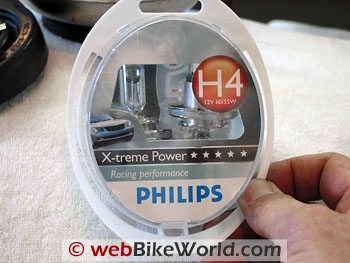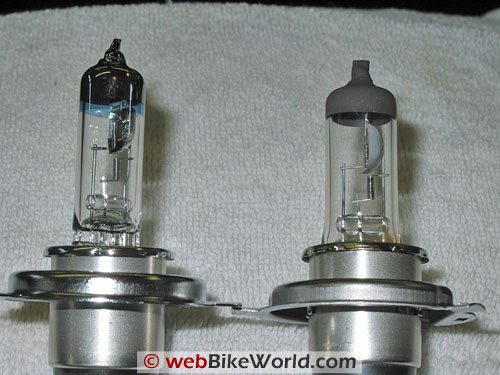Philips MotoVision and Philips X-treme Power Headlight Bulbs for Motorcycles
My wife feels the first day of summer is the saddest day of the year.
That’s because it means that the days have reached their peak in length and the slow decline into the long nights of winter are on the way.
She’s by no means a pessimist; she just loves those long days.
So do I, as I’m sure most of you do.
With the heat aside, those long days mean lots of nice riding weather and good visibility.
But the autumn equinox has passed and the days are rapidly shortening.
For those of us that commute by motorcycle, this means riding in the dark on both ends of the day. Even if you don’t commute, sunset comes quickly and it’s easy to wrap up a day’s ride in the dark.
I’m not afraid of riding in the dark; it’s just harder to see things in a timely manner to stay safe.
I’m a firm believer that, as a motorcyclist, there’s no such thing as having too much light. You need to be able to see hazards far enough in advance to be able to react to them.
That can be hard to do with the pitiful headlights some of the manufactures equip their products with.
Case in point is my 1999 BMW K1200LT (See my review on the Ducati Designs headlight conversion for that bike.) The stock headlights on the earlier K1200LT’s are a joke!
The first time I rode my 2006 Yamaha FJR1300 in the dark I was blown away with the headlights, both low and high beams.
The twin low and high beams throw out a lot of light.
I’ve been content with the stock arrangement, but while I was out of commission for 3 months because of a non-riding related arm injury I wondered (read- bored) how I could brighten things up a little without a lot of cost.
Philips Headlight Bulbs for Motorcycles
While browsing through Electrical Connection’s website for replacement bulbs, I happened across some bulbs manufactured by Philips.
Philips, it turns out, manufactures a wide array of replacement headlight bulbs for the consumer for automotive use.
Be sure to visit their website to view all of their products from bulbs with increased life, increasing levels of brightness to bulbs with a bluish tint. All of which are DOT compliant.
They’ve even developed a bulb they’ve named “MotoVision” that’s specifically for motorcycles. It produces an orange reflection with the intention to help bikes stand out in traffic.
I’m sure we’ve all seen the Philips name on lighting products for both the car and home in the stores, but what I didn’t know was that 50% of their business here in the USA, as in the rest of the world, is in medical systems.
There was a long delay between the time I placed the order at Electrical Connection and when they finally showed up on my doorstep.
The usual reply to my e-mails was that the bulbs were “still on order”. Since I wasn’t able to ride anyway at the time (remember the arm?) it was no big deal. By the time I was able to resume riding it was summertime.
When they did arrive the receipt showed an order for a pair of “E-DOT Vision Plus” Philips bulbs, but what I received was a pair of “X-treme Power / Racing Performance” bulbs, which are a superior product.
Frankly, it was so long between the time I placed the order and they arrived, I don’t remember exactly which ones I ordered.
The FJR uses the common H4 bulb with a 60/55 watt rating bulb which incorporates both a low and high beam element in one bulb. The “X-treme Power” bulbs are Philips’ top of the line replacement bulb.
They claim that they are “up to 80% brighter than standard halogen bulbs”, but are still rated the same in power consumption, i.e. wattage.
I’ve noticed on some sites that sell high performance aftermarket lights that some are for “off road use only”, but these from Philips are fully DOT compliant.
Once out of the package, visually, I could see very little difference between the stock bulb (which also happened to be manufactured by Philips) and their “X-treme Power” bulbs.
The “X-treme Power” bulbs appeared to have an improved reflective system, however. The elements looked the same in shape, length and wire gauge.
So, let’s get them installed and see if they’re really that much better!
Installing the Bulb
The FJR requires the removal of two upper body panels for access from above to the rubber covers on the back of the headlight assemblies (the screwdriver is pointing to the bulb location).
This was one of those, “I can see them and if I had really small hands I could probably sneak those suckers out without removing any Tupperware”.
But, as I’ve learned in 35+ years in the automotive field, doing it the correct way often saves you a ton of aggravation. With the rubber covers off, the bulbs are secured into the lenses via a collar that releases once rotated.
Be sure when handling the bulbs to NEVER touch the glass globes!
The oils from your skin can contaminate the glass, causing it overheat and shatter! Always hold them by the base plate or contact prongs!
Installation required very little time (20 minutes including pictures) and may be more or less difficult on your bike.
If you’ve never had to replace a headlight bulb, you should find out how it’s done and actually do it once or twice with good lighting.
You just never know when one might burn out. Just as wipers only fail when it rains, headlight failures are most often noticed only once it’s dark.
You really don’t want to be fumbling around in the dark trying to replace a bulb you’ve never attempted to remove before. It’s also good insurance to carry a spare bulb of each type on the bike.
I’m not an expert photographer and haven’t had much success getting decent photos of headlight patterns and intensity in the dark, so I chose to replace only the right side and compare the differences visually.
With one of each type bulb installed in the bike there was an obvious difference in the color and brightness, especially when looking up from the front tire into the headlamp reflectors.
The Philips “X-treme Power” bulbs were significantly brighter with little or no yellow tint.
Now it was time to put them to the real test, on the road. This was done on a combination of rural back roads and interstate driving. The results were, well, illuminating.
The “X-treme Power” bulbs by Philips provided a noticeable increase in what I would refer to as candle power which resulted in a brighter “splash” of light and reached further up the roadway.
They also picked up reflective objects sooner than the stock bulbs.
So, it was back to the house to replace the other side for the final effect which was very pleasing. The two bulbs together put out terrific illumination on low beam and the high beams are outstanding!
Now, my observations are purely subjective, but I would say the increase in illumination was more around the level of 25% over the stock bulbs. (I’m not sure which bulbs they were referring to when they claimed an 80% increase).
And, since the FJR has a handy knob on either side of the gauge cluster for separate headlight height adjustment, it was easy to tweak the settings on the fly.
Conclusion
As motorcyclists, we need all the help we can get to stay safe out there on the roadways.
That means seeing well as much as being seen. Mounting auxiliary lights is not an option all riders have considering the limitations of the charging systems on many bikes.
Upgrading the stock bulbs in your bike with the “X-treme Power” bulb from Philips can be both a simple and inexpensive solution. Both of which make for my favorite kind of “farkle”.
I was only charged $29.95 plus $8.95 for S&H for a pair of bulbs, but they seem to run more along the lines of $39.95 on most websites.
Available through major Automotive parts suppliers and some department stores.
| wBW Review: Philips Motorcycle Light Bulbs | |
|---|---|
| Manufacturer: Philips (buy them here) | List Price (2007): $29.95 |
| Colors: N/A | Made In: U.S.A. |
| Review Date: December 2007 | |




No Comment